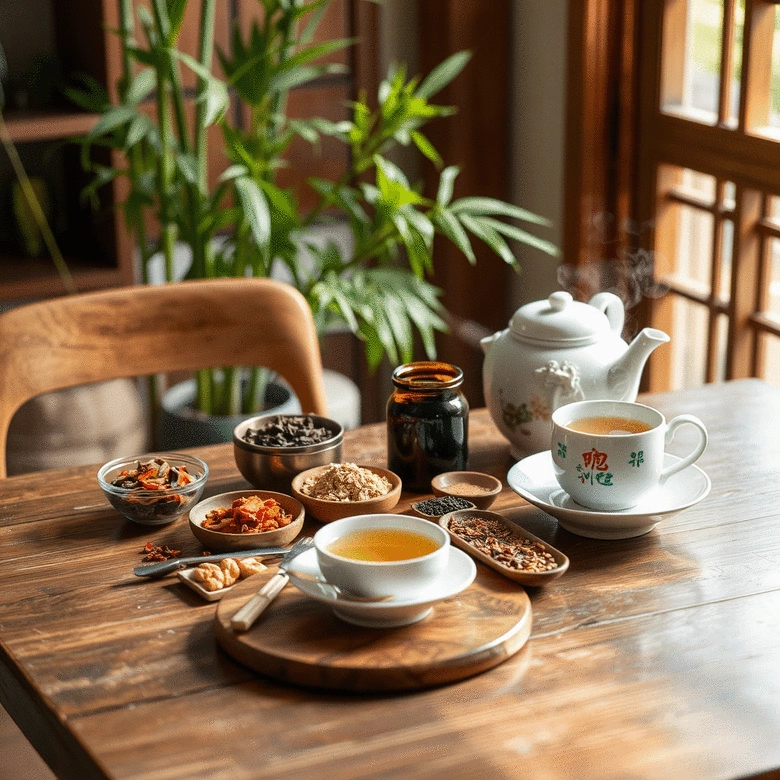Healing with Seasonal Chinese Medicine
How often do you consider the impact of the changing seasons on your health and well-being? Traditional Chinese Medicine (TCM) teaches that embracing natural cycles can enhance our vitality and emotional balance. By aligning our wellness practices with the seasons, we can tap into the unique energies each time of year offers. Here’s what you will learn from this exploration of seasonal healing practices in TCM.
What You Will Learn
- Awareness of Seasonal Changes: Recognizing how the seasons affect our physical and emotional health can lead to improved well-being.
- Adapting Lifestyle: Adjusting routines to align with seasonal energies enhances health and vitality.
- Elemental Integration: Understanding and using the Five Elements of TCM can enrich wellness practices tailored to each season.
- Emotional Resilience: Seasonal practices can help develop emotional balance through mindful reflection and creative expression.
- Mind-Body Connection: Aligning physical activities with seasonal changes can promote holistic healing and awareness.
- Bridging Healing Modalities: Integrating TCM with Western medicine fosters a comprehensive approach to health and well-being.
- Stress Management Techniques: TCM offers unique strategies like Qi Gong, acupuncture, and herbal remedies to combat stress.
Benefits of Seasonal Healing Practices in TCM
Aligning wellness practices with seasonal changes can enhance well-being significantly. The following key benefits highlight the advantages of these practices:
Boosted Immune System
Seasonal transitions can strengthen the immune response, making the body more resilient.
Improved Emotional Balance
Aligning with seasonal energies enhances emotional stability and resilience.
Increased Energy Levels
Engaging in seasonal activities can boost overall vitality and energy.
Understanding Traditional Chinese Medicine and Its Seasonal Applications
When we delve into the beauty of Traditional Chinese Medicine (TCM), we uncover a world where health is intricately woven with the cycles of nature. At Needle & Nature, I often reflect on how embracing these seasonal rhythms can profoundly impact our well-being. TCM teaches us that just as the seasons change, so too do our bodies and their needs, inviting us to adapt our healing practices accordingly. Have you ever thought about how the season affects your mood or energy levels?
In TCM, seasonal healing practices focus on aligning our physical and emotional health with the changing environment. By understanding these shifts, we can tailor our approaches to wellness, enhancing our vitality and emotional balance. This article on acupuncture for seasonal wellness offers a deeper dive into how these natural rhythms guide us on the journey to holistic health.
Defining Seasonal Healing Practices in Chinese Medicine
At the heart of TCM lies the belief that each season has its unique qualities that influence our bodies. For example, spring is seen as a time for renewal, while autumn encourages letting go. Seasonal healing practices often involve adjustments in our daily routines, including diet, activity levels, and even our mindset. For a deeper understanding of how each season is viewed in TCM, you can explore resources like WTHN's guide to the 5 seasons in Traditional Chinese Medicine. Here are some key principles of seasonal healing:
- Awareness of Seasonal Changes: Paying attention to the changes around us can enhance our well-being.
- Adapting Lifestyle: Adjusting our routines to match seasonal energies fosters better health.
- Holistic Integration: Combining mind, body, and spirit practices helps us resonate with nature.
By recognizing and embracing these principles, I encourage my clients at Needle & Nature to see their health as a dynamic relationship with the world around them. How might your life change if you aligned your wellness practices with the seasons?
The Role of Nature and Health in TCM
Nature plays a pivotal role in TCM, reminding us that we are not separate from the environment but rather a part of it. Each season brings specific energies that can either support or challenge our health. For instance, winter invites introspection and rest, while summer encourages growth and joy. By embracing these natural cycles, we can cultivate a deeper connection to our own health journeys. The importance of aligning with natural rhythms for optimal well-being is a core tenet of TCM, as highlighted by various perspectives on seasonal healing and acupuncture.
Here are some ways nature influences our health in TCM:
- Natural Rhythms: Aligning our wellness with the natural rhythms enhances our vitality.
- Elemental Balance: Each season is associated with one of the Five Elements, guiding our focus on specific organs.
- Environmental Awareness: Understanding environmental factors can aid in prevention and treatment.
At Needle & Nature, I often encourage clients to connect more deeply with their surroundings. This connection can foster a greater sense of peace and harmony, allowing us to thrive amidst life's demands.
Integrating the Five Elements Theory in Seasonal Practices
The Five Elements Theory is essential in TCM, linking our health to the natural world through Wood, Fire, Earth, Metal, and Water. Each element corresponds with specific organs, emotions, and seasonal characteristics, guiding our healing practices. For example, as we move into spring, the Wood element resonates with the liver, promoting growth and renewal. Understanding these connections can enrich our seasonal wellness routines, as discussed in detail regarding the art of spring wellness and aligning with nature through TCM.
To integrate the Five Elements into your seasonal practices, consider the following:
- Identify Correspondences: Recognize which element aligns with the current season.
- Focus on Specific Organs: Tailor your wellness practices to support the organs associated with that element.
- Embrace Elemental Features: Utilize foods, activities, and practices that resonate with the element's qualities.
By incorporating the Five Elements into our seasonal practices, we can create a harmonious balance that nurtures our bodies and spirits. At Needle & Nature, I love guiding individuals to explore these elements as they embark on their own journeys of wellness. How might you connect with the elements as the seasons change?
Quick Summary
Here's a brief recap of the key points discussed so far:
- Traditional Chinese Medicine (TCM) emphasizes aligning health with seasonal changes.
- Each season has unique qualities that influence our bodies, emotions, and wellness practices.
- Integrating the Five Elements Theory into seasonal practices can enhance our holistic health.
- Aligning with nature’s rhythms boosts immunity, emotional balance, and overall vitality.
Benefits of Aligning with Seasonal Healing Practices
Aligning our wellness practices with the seasons can offer profound benefits for our overall well-being. When we embrace the rhythms of nature, we cultivate a deeper awareness of how these changes affect our health. From physical vitality to emotional resilience, seasonal healing practices guide us toward a more harmonious and balanced existence. Have you ever felt a surge of energy or calmness during a particular season? This connection is not just a coincidence; it’s an invitation to align with the energies around us.
One of the most remarkable aspects of seasonal practices is their ability to enhance our well-being. By tuning into the natural world, we can make lifestyle choices that support our bodies and minds. Regularly incorporating seasonal elements can lead to improvements in mood, energy levels, and overall health. Consider how you might feel after a refreshing spring cleanse or a grounding autumn ritual—what transformations could these practices ignite in your life?
- Boosted immune system during seasonal transitions
- Improved emotional balance and resilience
- Increased energy and vitality aligned with seasonal activities
Developing Resilience and Emotional Balance
Seasonal healing practices can significantly contribute to our emotional health. As we transition through the seasons, we often encounter various emotional states—reflective and introspective in winter, vibrant and hopeful in spring, joyful and active in summer, and contemplative in autumn. Recognizing these natural shifts allows us to better understand our feelings and develop resilience. It’s incredible how aligning our emotional states with the seasons can lead to greater harmony within ourselves!
To nurture emotional balance, consider integrating the following practices into your routine:
- Mindful reflection during winter’s quiet moments
- Creative expression as spring awakens
- Social gatherings to enhance summer joy
- Introspection and gratitude in autumn
Understanding the Mind-Body Connection in Seasonal Healing
The mind-body connection plays a vital role in seasonal healing. When we intentionally align our physical practices with the changing seasons, we can foster a sense of harmony and balance. Imagine how your body feels after engaging in activities that resonate with the season—whether it’s a gentle winter yoga session or a brisk spring walk in nature. Each seasonal practice can promote healing on multiple levels, reminding us that we are intricately linked to the world around us.
At Needle & Nature, we believe in the transformative potential of honoring this connection. By embracing the Five Elements and their seasonal alignments, we can create a holistic approach that nurtures both our bodies and minds. Have you thought about how your emotions shift with the seasons? Acknowledging this connection allows for a deeper understanding of yourself and your health journey.
- Increased mindfulness and awareness of bodily sensations
- Enhanced emotional responses to seasonal changes
- Improved physical health through seasonal lifestyle adjustments
Frequently Asked Questions About Seasonal Healing in TCM
- Q1: What is Traditional Chinese Medicine (TCM) and how does it relate to seasons?
- A1: Traditional Chinese Medicine (TCM) is a holistic healthcare system that views health as intricately linked to the cycles of nature. It emphasizes aligning our physical and emotional well-being with seasonal changes to maintain vitality and balance.
- Q2: What are the key benefits of practicing seasonal healing in TCM?
- A2: Aligning with seasonal healing practices in TCM offers several benefits, including a boosted immune system, improved emotional balance and resilience, increased energy levels, and a deeper mind-body connection.
- Q3: How does the Five Elements Theory integrate into seasonal practices?
- A3: The Five Elements Theory (Wood, Fire, Earth, Metal, Water) is central to TCM. Each element corresponds to specific organs, emotions, and seasonal characteristics. Integrating this theory involves tailoring wellness practices to support the organs and qualities associated with the current season, such as focusing on the Wood element and liver in spring.
- Q4: How can seasonal healing practices help with emotional balance?
- A4: Seasonal healing practices help us recognize and adapt to the natural emotional shifts that occur with each season. By engaging in mindful reflection, creative expression, social gatherings, and introspection aligned with the seasons, we can nurture emotional resilience and harmony.
- Q5: Can TCM be combined with Western medicine for better health outcomes?
- A5: Yes, integrating TCM with Western approaches offers a comprehensive path to holistic health. By combining the preventative and balancing focus of TCM with the acute care of Western medicine, individuals can achieve optimal results, such as blending acupuncture with modern treatments.
Bridging Traditional Chinese Medicine and Western Approaches
The integration of Traditional Chinese Medicine (TCM) with Western approaches offers a dynamic pathway to holistic health. While TCM emphasizes the importance of natural cycles, Western medicine often focuses on treating specific symptoms. However, by combining these perspectives, we can create a more comprehensive approach to health that honors both the individual and their environment. Recognizing the strengths of each system can open new doors for healing and well-being.
Consider the following comparative insights as we explore how TCM and Western medicine can work together:
- TCM: Focus on balance and prevention through seasonal practices
- Western Medicine: Emphasis on acute care and symptom management
- Collaborative care: A blend of acupuncture and modern treatments for optimal results
Integrative Approaches for Holistic Health
Engaging with integrative approaches allows us to explore the richness of our health options. By weaving together the threads of TCM and Western practices, we can enhance our wellness experiences. This collaboration encourages us to consider our physical, emotional, and spiritual health as interconnected. Have you ever experienced the benefits of combining holistic practices with conventional treatments? It can be a powerful journey!
To begin your journey toward integrative health, consider:
- Consulting with healthcare practitioners who embrace both TCM and Western methodologies
- Exploring dietary therapies that align with seasonal changes
- Incorporating mindfulness practices alongside medical treatments for enhanced well-being
Exploring Stress Management Techniques in TCM
Stress management is essential for maintaining overall health, and TCM offers unique perspectives on this important aspect of wellness. By understanding the seasonal impacts on our stress levels, we can implement effective techniques to cultivate peace and balance in our lives. Whether it’s through acupuncture, herbal remedies, or lifestyle adjustments, TCM provides a variety of tools to help manage stress in alignment with nature’s cycles.
To effectively combat stress through TCM, you might consider:
- Practicing Qi Gong or Tai Chi to promote relaxation and balance
- Using acupuncture to release tension and restore energy flow
- Incorporating herbal remedies that support emotional well-being
By embracing these techniques, we can foster a sense of calm and resilience in the face of life’s challenges!
Recap of Key Points
Here is a quick recap of the important points discussed in the article:
- Awareness of Seasonal Changes: Recognizing the seasonal shifts enhances well-being and encourages lifestyle adjustments.
- Holistic Integration: Combining mind, body, and spirit practices fosters a deeper connection to nature and personal health.
- Five Elements Theory: Understanding the relationship between the seasons and the Five Elements can enrich wellness routines.
- Emotional Balance: Aligning emotional responses with seasonal changes can promote resilience and harmony.
- Integrative Health Approaches: Blending Traditional Chinese Medicine with Western practices offers a comprehensive pathway to wellness.
- Stress Management Techniques: Utilizing TCM practices such as Qi Gong, acupuncture, and herbal remedies can effectively manage stress and promote relaxation.






